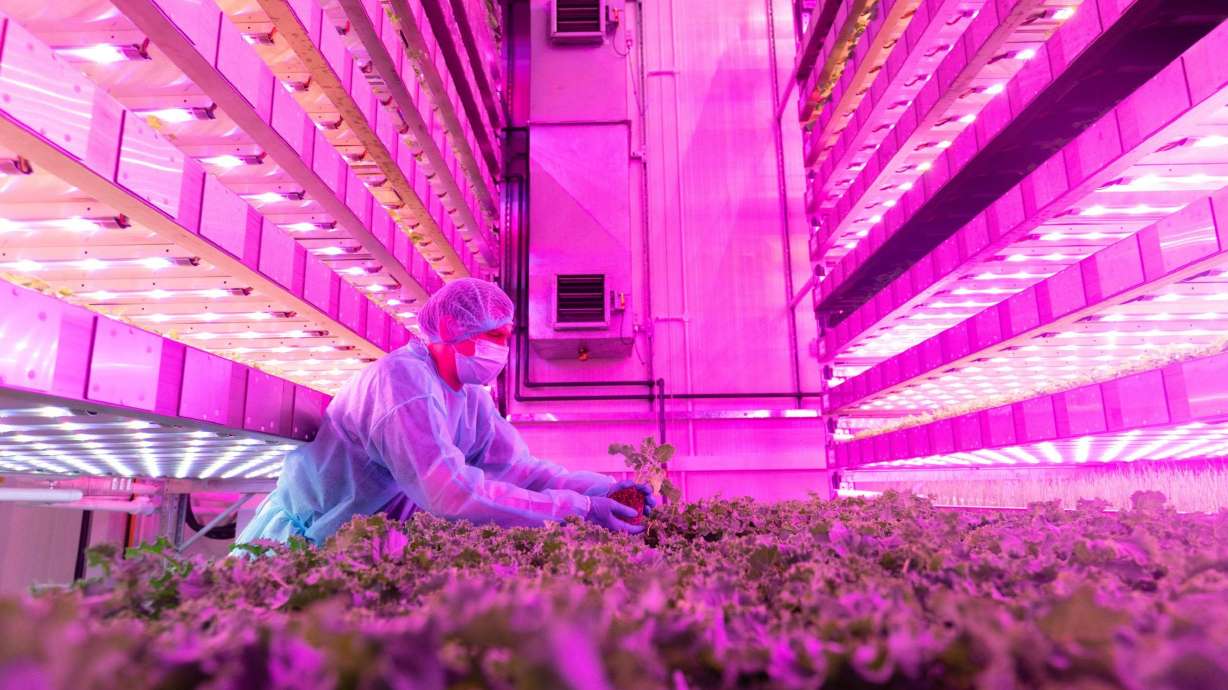Estimated read time: 5-6 minutes
This archived news story is available only for your personal, non-commercial use. Information in the story may be outdated or superseded by additional information. Reading or replaying the story in its archived form does not constitute a republication of the story.
WASHINGTON — In 2022, Dubai unveiled the world's largest vertical farm. The nearly 102,000-square-foot indoor facility at Dubai's Al Maktoum International Airport, comprised of trays stacked in towers growing plants with minimal water and soil, produces more than 2.2 million pounds of high-quality leafy greens each year.
But it's not going to hold the title for long. On the other side of the city, at the aptly named Food Tech Valley, work on an even bigger facility is underway: a 39-foot-high, 274,000-square-foot "GigaFarm."
GigaFarm project, overseen by United Arab Emirates-founded enterprise ReFarm, is not just larger than other vertical farms — it operates differently, too, says Oliver Christof, CEO at Christof Global Impact, the company behind ReFarm.
Food systems are estimated to be responsible for a third of global greenhouse gas emissions, according to the U.N. The land-based sector, including agriculture and land use, makes up two-thirds of this, with production, including fertilizers, contributing 39% of the total, and distribution of produce 29%.
To make farming greener, GigaFarm plans to use a suite of technologies that can transform waste streams — such as food scraps and sewage — into agricultural products like compost, animal feed, clean water and energy.
By bringing the farms closer to consumers and using more efficient production methods to reduce fertilizer use, the system promises to cut the carbon footprint of food production, growing up to 6.6 million pounds of leafy greens, herbs, and vegetable seedlings annually and replacing up to 1% of the UAE's food imports, says Christof.
'Not just another vertical farm'
GigaFarm's vertical farming solution is supplied by IGS, a Scottish company founded in 2013.
IGS's "growth towers" — which look similar to a multistory car park, stacked with plants instead of vehicles — are a controlled environment that carefully monitors and regulates the frequency and quantity of water and fertilizers.
Using a hydroponics system, each tray grows plants using a substrate, such as organic compost or coconut fibers, instead of soil, and LED light strips under each tray provide synthetic sunlight. Sensors, including cameras, monitor plant growth, and the towers can automatically manage light, temperature, humidity, water and nutrient levels.
Ranging from about 20 to 39 feet in height, the towers are modular, making them easy to scale, says Andrew Lloyd, CEO of IGS. "Put 200 of them in one place, then you've got a GigaFarm."
Zig-zagging girders hold dozens of trays, which can be moved between towers. Each tower module is padded with thick, insulating foam panels that keep the interior carefully climate-controlled.
"Once you've got the air in, and you've got the humidity and the temperature under control, the level of replenishment of that is incredibly tiny," says Lloyd.
Vertical farming offers a multitude of benefits over conventional agriculture, including faster crop growth, reducing water use by up to 98%, and taking up far less space. Additionally, vertical farms can be built in places where soil has been degraded and is unusable for traditional agriculture, and indoor farms are not restricted by seasons and climate.
But there are drawbacks, too. The smart technology and infrastructure present a huge upfront investment, and the high running cost of the farms, largely made up of electricity bills from the LED lights, have seen many companies struggle.
A recent string of high-profile financial failures in the sector — including Fifth Season and AppHarvest, which both filed for bankruptcy last year — highlight the difficulty of competing with the low costs of conventional agriculture. In 2023, U.S. vertical farming company AeroFarms opened a 65,000-square-foot research and development facility in Abu Dhabi, the largest of its kind in the world, but shortly after, the company filed for bankruptcy and restructured.
To make a vertical farm sustainable, both financially and environmentally, it needs to integrate waste streams and renewable energy, says Lloyd — which is just what ReFarm plans to do.
The farm will be powered with energy produced from incinerating its solid waste, while its water will be supplied by an insect-based technology. Black soldier fly larvae eat the food waste, and at the end of their growth cycle, are turned into high-protein animal feed, with water and compost as byproducts. GigaFarm expects to recycle 50,000 metric tons of food scraps annually, and the water generated from this process is enough to "run 100% of the vertical farm," says Christof, while the organic compost will be used as a substrate for the plants.
The animal feed is one of several agricultural products ReFarm plans to make at the facility and sell to farms. It's also making a biofertilizer which ReFarm claims cuts fertilizer application by 50%, and a soil enhancer that can restore "depleted soil or sand" to better absorb water, microorganisms, and fertilizer, says Christof. The facility will also process wastewater, removing ammonia to reuse in fertilizers.
By using the GigaFarm to grow seedlings for the UAE's 38,000 operational farms — of which many use hydroponics or high-tech greenhouses — Lloyd says ReFarm can go beyond "scratching the surface" of the problem, and "actually make a dent" in food security.
"This is not just another vertical farm, this is something completely different," says Lloyd, adding that the recycling model could be applied to any urban area.
"Wherever humans are, you will find waste. We can take the waste and turn it into value, whether that value is the food that we're growing or whether it is replacing hydrocarbon-intensive things like the biofertilizers," says Lloyd. "We have to do this, otherwise we're going to run out of planet."
The $326.7 million GigaFarm project will break ground later this year, and is expected to be fully operational by 2026.








